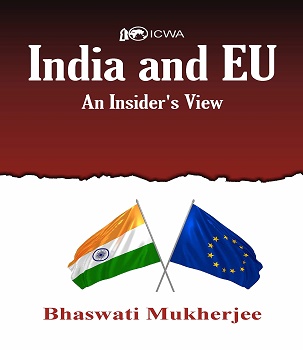Although India was among the first countries to develop ties with the European community in the 1960s, the country’s present level of engagement with the European Union (EU) is not commensurate with the existing potential. The four-year long hiatus between the twelfth (2012) and thirteenth India-EU summits (2016) marked the lowest phase of the partnership. With the resumption of dialogue since 2016, a revival of their relations has followed but still lacks the required momentum. Several factors are responsible for this slow pace of progress are discussed at length in ‘India and EU: An Insider’s View’ by former Indian ambassador Bhaswati Mukherjee.
As the title underlines, the book is presented as an insider’s account on the various facets of the India-EU diplomatic trajectory- the ups and downs, achievements and setbacks over the last two decades. Ambassador Mukherjee has to her credit several key European postings. She also served as the Joint Secretary in the Western Europe Division of the Ministry of External Affairs, New Delhi from 1998-2004, a crucial juncture in the evolution of India-EU ties when the summit level dialogues began. As one of the most experienced diplomats specialising in European affairs and particularly the India-EU partnership, she understandably lends a credible and much needed ‘view’ on India-EU relations.
The author begins with ‘a narrative about Europe meeting India’ (p.xiii). After providing a brief historical account of India’s ties with Europe, she proceeds to discuss India’s ties with Europe through ‘the prism of the EU’ and highlights the existing commonalties and differences between them. She observes that despite a different history and distant geography, there are ‘striking parallels in the separate journeys of EU and India’ both of who are culturally diverse within and represent the largest democracies in the world In this context, she compares the similar and unique ‘process of institution building’ which both the EU and India have undergone while balancing ‘the rights of their citizens with the need for cohesion’ (p.5).
Before delving into India- EU relations in Chapter three, the author also discusses the ‘intra-state’ structure of the EU. Here, she succinctly outlines the complex institutional structure and processes of the EU which is barely understood in India. As she observes later in the book, the prevailing Indian public opinion, knowledge and (mis) perceptions about the EU institutions and vice versa is one of the biggest impediments to achieving ‘a dynamic strategic partnership’ (p.67).
The author encapsulates the evolution and development of India-EU relations since the 1990s in the following two chapters. She then goes on to discuss the internal developments that have challenged the cohesion within the EU and rekindled the debate about ‘the advantages of regionalism vis à vis nationalism’ (p.145). In this context she brings up the issue of Brexit in the sixth chapter. Here she notes that contrary to popular opinion, ‘there are indications that Brexit may strengthen the unity of the Union rather than weaken it’ (p.142). She backs this observation by citing the resounding victory of President Emmanuel Macron in France soon afterwards as well as the unity demonstrated by the EU during negotiations with Britain on the exit plan.
With respect to Brexit’s implications for India-EU dynamic, she notes that an adverse impact on India-EU relationship seemed unlikely given that India’s relationship with EU was independent of its relations with Britain. On the contrary, she notes that the relationship might prosper further owing to their common challenges and positions on several international issues like terrorism, climate change, etc. In this context, she cites the maiden International Solar Alliance (ISA) summit held in New Delhi, during President Macron’s first visit to India in March 2018. As the author puts it, the summit ‘marked a new phase in India’s partnership with France and the EU on climate change and renewable energy issue’ (p.268) and would play a strong role in consolidating the India-EU strategic partnership.
In Chapters seven and eight, Ambassador Mukherjee discusses all the thirteen summits since 2000 and their outcomes. Before resuming her analysis on the content and outcomes of the fourteenth summit, she discusses at length the stalled Bilateral Trade and Investment Agreement (BTIA) in chapter nine which continues to be a major stumbling block in the progress of India-EU partnership to date. This comprehensive chapter is especially notable for bringing out the nuances in the EU-India dynamic. Referring to the BTIA roadmap as a ‘formidable wish list’ she observes that both India and EU have been envisioning ‘not just a simple FTA but a much larger pact including services and intellectual property’. She notes that it is the sheer scope of the FTA that ‘remains the root of the problem’ (p.227).
As such, a breakthrough would depend upon the extent to which both sides succeed in ‘bridging the gap’ and move towards ‘a dynamic relationship which corresponds with the political needs of sides as well as a pragmatic business relationship’ (p.283). She resumes her discussion on the summit level dialogue in the tenth chapter and follows it up with a concluding chapter on the way forward.
Overall, the book is well written and makes for an engaging read. It follows a linear approach to present yearly (summit wise) developments and setbacks besides the stagnant phases in the EU-India Partnership. The author targets the EU for its preoccupation with China as well as its concessions towards Pakistan. She also touches upon the EU’s rather prescriptive approach towards India’s internal issues but acknowledges the ‘evolutionary’ shifts in the EU’s policy priorities in the concluding chapter (p.270). According to her, the multiple crises within the EU have facilitated ‘a more collegial approach with a greater understanding of the complexities of India’s problems and its strategic priorities in its increasingly difficult and dangerous neighbourhood’ (p.275). At the same time, the author also admits that India too bears responsibility for delayed progress as the country was rather slow in responding to EU overtures of a strategic partnership in the initial years.
In addition, she reiterates the lack of understanding by ‘Indians in general and the Indian media in particular’ as a result of which there have been no efforts to interlink them into India’s foreign policy imperatives (p.67). She also notes that this passive Indian outlook has seen a shift in recent times. This is because several of India’s current global objectives such as the reform of the United Nations Security Council, climate change and global warming as well as the International Solar Alliance (ISA) concur with the EU’s priorities to a great extent. Nevertheless, as the author argues ‘deal making requires realism on both sides’ (p.224). Thus, along with focusing on the ‘it would serve well for both sides to avoid being distracted by other priorities and concerns’ (p.269).
The book a timely contribution to the literature on India-EU relations and provides a much-needed Indian perspective on European affairs. It is a must read for anyone interested in understanding the nuances of the India-EU partnership. The simple narrative of the book and detailed endnotes at the end of each chapter make it a useful primer for the study of India-EU relations.











Post new comment